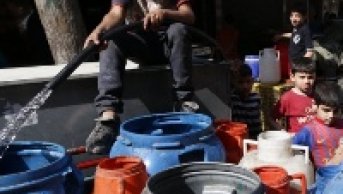Will Turkey Face Water Scarcity in 2030?

As is well known, water covers approximately 70 percent of the Earth's surface. However, 97.5 percent of surface water is salt water in the oceans and seas. The remaining 2.5 percent is fresh water. But water is not evenly distributed around the globe. While there is an abundance of water in some areas, we may see growing water shortages in others. Turkey, which has a varied climate due to significant topographic variations, suffers moderate drought once every six years and a severe meteorological drought every 18 years.
According to the water budget of the State Waterworks Authority (DSİ), Turkey's mean annual precipitation is 643 millimeters, which corresponds to 501 billion cubic meters of water. Of this, 274 billion cubic meters evaporate, while 69 billion cubic meters of water leak into aquifers and thus are lost to the water budget. Of the total amount, 158 billion cubic meters are mixed with rivers and lakes as surface water. While 7 billion cubic meters of water come from neighboring countries, 42 billion cubic meters of water are retrieved from groundwater contributing to surface water, and this amount is included in the water budget. Turkey's overall water potential equals 193 billion cubic meters. Considering the country's economic and technical constraints, the annual exploitable water potential has been calculated at 112 billion cubic meters. According to the Ministry of Development's plan for 2014, Turkey currently uses 39 percent of its exploitable water potential.
Irrigation accounts for 73 percent of water usage, 16 percent is used as drinking water and 11 percent in industry. According to the ministry's calculations, the exploitable amount of water in Turkey was 1,500 cubic meters per capita this year. It is estimated that the annual available amount of water per capita will fall to 1,100 cubic meters by 2030. According to the Falkenmark Index, which classifies countries in terms of their amount of water potential per capita, Turkey is a country with "water stress," since it has 1,000-1,500 cubic meters of water potential per capita. According to the same scale, if Turkey's per capita water potential were to fall below 1,000 cubic meters, the country would enter a state of water scarcity.
A growing population, urbanization, climate change, leaks in water distribution pipelines, mismanagement of water resources and inappropriate irrigation methods have a negative impact on the amount and quality of water resources and their efficient use.
For this reason, Turkey has taken steps on water management in recent years. The Ministry of Forestry and Water Affairs was established on June 4, 2011, to coordinate national water management. The General Directorate of Water Management, under the ministry, is responsible for creating policies to better utilize water resources as well as develop a national and international water management policy. This general directorate was established to gather the dispersed water management structure under a single organization. Also, as a candidate country for European Union membership, Turkey has been required to integrate the EU Water Framework Directive into its water-related policies, regulations and laws since 2009. Within the process of harmonization with the EU Water Framework Directive, the General Directorate of Water Management has been carrying out a capacity development project to establish an effective monitoring system for water quality, preparing River Basin Protection Action Plans (RBPAP), determining specific provisions for the Capacity Building to Implement the Flood Directive in Turkey and carrying out the project.
Within this process, preparations for a new water law were brought onto the agenda. As the Law on Water (1926) was unable to meet existing needs, a new water law was needed that would also address the conflict between authority and responsibility in current water legislation, the gaps in water-related legislation, the growing population, urbanization and the necessity of assessing water not only in terms of quantity but also in terms of quality. For this reason, a process was launched to prepare a new water law. Currently, the draft work has been completed and opened for discussion, and with the new water law, being reviewed before its presentation to Parliament, the aim is to further reinforce the implementation of the EU Water Framework Directive while also meeting Turkey's needs. These new structures are being made to allow greater efficiency in the water system. But are they enough to solve the looming problem of water scarcity in Turkey? The answer is "No."
Above all, this structure based on demand management must shift towards supply-oriented management in line with the global trend. Furthermore, it is not only water suppliers but also other stakeholders who should act on this issue. People should be well-informed and take responsibility for the efficient use of water resources to provide the maximum yield. On the other hand, climate change is an undeniable environmental problem around the globe. Water resource management systems must be flexible and powerful enough to adjust to different precipitation trends, periods of drought and new climatic conditions.







